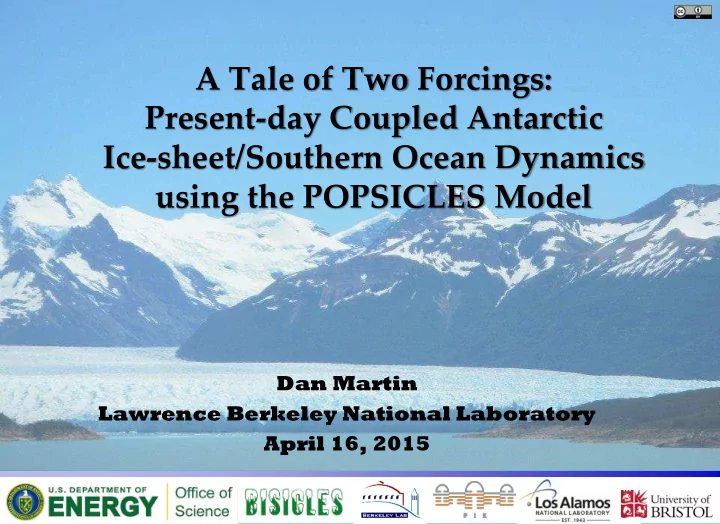

A Tale of Two Forcings: Present-day Coupled Antarctic Ice-sheet/Southern Ocean Dynamics using the POPSICLES Model Dan Martin Lawrence Berkeley National Laboratory April 16, 2015
Joint work with: Xylar Asay-Davis (Potsdam-PIK) Stephen Cornford (Bristol) Stephen Price (LANL) Doug Ranken (LANL) Mark Adams (LBNL) Esmond Ng (LBNL) William Collins (LBNL)
Coupled Ice and Ocean Models: Ocean Circulation Model: POP2x Ice Sheet: BISICLES (CISM-BISICLES) POP + BISICLES = POPSICLES
Coupling: Synchronous-offline Monthly coupling time step ~ based on experimentation • BISICLES POP2x: (instantaneous values) • • ice draft, basal temperatures, grounding line location POP2x BISICLES: (time-averaged values) • • (lagged) sub-shelf melt rates Coupling offline using standard CISM and POP netCDF I / O • POP bathymetry and ice draft recomputed: • • smoothing bathymetry and ice draft, thickening ocean column, ensuring connectivity • T and S in new cells extrapolated iteratively from neighbors • barotropic velocity held fixed; baroclinic velocity modified where ocean column thickens/thins 1 Goldberg et al. (2012)
Antarctic-Southern Ocean Coupled Simulations BISICLES setup: Full-continent Bedmap2 (2013) geometry Initialize to match Rignot (2011) velocities Temperature field from Pattyn (2010) 500m finest resolution (adaptive mesh refinement) Initialize SMB to “steady state” using POP standalone melt rate
Antarctic-Southern Ocean Simulation POP setup: Regional southern ocean domain (50-85 S) ~5 km (0.1 ) horizontal res.; 80 vertical levels (10m - 250m) Initialize with stand-alone (3 & 20 years) run; Bedmap2 geometry
Two forcing regimes LANL “Normal Year” monthly mean forcing CORE InterAnnual Forcing (CORE-IAF)
Normal-Year Coupled Simulations What Happens? Cold bias -- Melt rates are spinning down over time (POP issue) • Possible causes – • Over-stratification (too much freshwater forcing?) • climate forcing? • • no sea ice model? (Regional-mode POP issue)
Normal-year Coupled Sims (Ice sheet) Compare Standalone vs. Coupled runs: “Steady - state” initial condition isn’t quite (mass gain) • Melt rates are spinning down over time (POP issue) • • Can see effect of coupling (gains mass faster than standalone)
Antarctic-Southern Ocean Coupled Sims (cont)
Antarctic-Southern Ocean Coupled Sims (cont)
Antarctic-Southern Ocean Coupled Sims (cont)
Antarctic-Southern Ocean Coupled Sims (cont)
Normal Year vs. CORE-IAF: Impact on melt rates Switching to CORE- IAF forcing switches cold bias to warm… • Mixing of CDW into upper ocean • Destratification from freshwater forcing? (Joakim Kjellsson’s talk Tuesday) • Lack of Dynamic Sea Ice?
Coupled Antarctica: Core-IAF o Response dominated by loss of floating area in a few sectors ( Getz !) o This was supposed to be the warming scenario o What happened? (Getz sector!)
Getz Ice shelf -- Regrounding instability (cont)
Getz Ice shelf -- Regrounding instability (cont) What happened? Bedmap2 – poorly constrained subshelf bathymetry “Made stuff up” – - reasonable from the ice-sheet perspective Resulted in very thin (< 100m) subshelf cavities under the ice Nominal/standalone POP2x melt rates fairly high Large synthetic accumulation field to balance melt and keep shelf in steady state Time-dependent runs – instability Small relative fluctuations in melt-rate forcing can result in thickness changes which are O( cavity thickness) Localized grounding Subself melting turns off – unbalanced (and large!) accumulation Leads to more regrounding - > more unbalanced melt….
Warmwater incursion – Amery Warmwater incursion in Amery basin Increased melt rate – front reaches end of cavity in 9-10 years Moderate GL retreat
Warmwater Incursion – Amery (cont)
Warmwater Incursion – Amery (cont)
Warmwater incursion – Amery (cont) cross-section movie.
Ronne-Filchner
Ronne-Filchner Ice Shelf
Ronne-Filchner Ice Shelf
Ronne-Filchner Ice Shelf
Ross Ice Shelf
Ross Ice Shelf
Ross Ice Shelf
Future work Fix issues exposed during coupled run and try again. Deepen bathymetry in problem regions (RTOPO1) BISICLES initial condition -- realistic (Arthern?) SMB More realistic climatology/forcing leading to “real” projections
Deepening bathymetry -- Totten
Thank you!
Extras
Computational Cost Run on NERSC’s Edison For each 1-month coupling interval: POP: 1080 processors, 50 min BISICLES: 384 processors, ~30 min Extra “BISICLES” time used to set up POP grids for next step Total: 1464 proc x 50 min = ~15,000 CPU-hours/simulation year (~1.5M CPU-hours/100 years)
Motivation: Projecting future Sea Level Rise Potentially large Antarctic contributions to SLR resulting from marine ice sheet instability, particularly from WAIS. Climate driver: subshelf melting driven by warm(ing) ocean water intruding into subshelf cavities. Paleorecord implies that WAIS has deglaciated in the past.
Big Picture -- target Aiming for coupled ice-sheet-ocean modeling in ESM Multi-decadal to century timescales Target resolution : Ocean: 0.1 Degree Ice-sheet: 500 m (adaptive) Why put an ice-sheet model into an ESM? fuller picture of sea-level change feedbacks may matter on timescales of years, not just millennia
BISICLES Ice Sheet Model Scalable adaptive mesh refinement (AMR) ice sheet model Dynamic local refinement of mesh to improve accuracy Chombo AMR framework for block-structured AMR Support for AMR discretizations Scalable solvers Developed at LBNL DOE ASCR supported (FASTMath) Collaboration with Bristol (U.K.) and LANL Variant of “L1L2” model (Schoof and Hindmarsh, 2009) Coupled to Community Ice Sheet Model (CISM). Users in Berkeley, Bristol, Beijing, Brussels, and Berlin…
POP and Ice Shelves Parallel Ocean Program (POP) Version 2 Ocean model of the Community Earth System Model (CESM) z-level, hydrostatic, Boussinesq Modified for Ice shelves: partial top cells boundary-layer method of Losch (2008) Melt rates computed by POP: sensitive to vertical resolution nearly insensitive to transfer coefficients, tidal velocity, drag coefficient
Issues emerging from 1 st coupled Antarctic Runs Fixed POP error in freezing calculation. (resulted in overestimated refreezing) POP cold bias (spin-down of melt rates) Issue with artificial shelf-cavity geometry in Bedmap2 Bedmap2 specifically mentions Getz, Totten, Shackleton Very thin subshelf cavities (constant 20 m!) result in high sensitivity to regrounding Interacted with POP Thresholding cavity thickness Need better initialization
Warmwater incursion – Amery (cont) Meltrate movie
Getz Ice Shelf – Regrounding Instability
Getz Ice shelf -- Regrounding instability
Recommend
More recommend